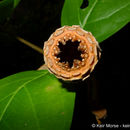Comments
provided by eFloras
Calycanthus occidentalis grows in the northern Coast Range, the southern Cascades Range, and the western Sierra Nevada. It is ecologically similar to C . f loridus ; it consistently differs from that taxon in a number of vegetative and floral characteristics. Because of an apparent lack of hardiness, C . occidentalis is cultivated less often than C . floridus .
Some American Indians used scraped bark of Calycanthus occidentalis medicinally in treating severe colds (D. E. Moerman 1986).
- license
- cc-by-nc-sa-3.0
- copyright
- Missouri Botanical Garden, 4344 Shaw Boulevard, St. Louis, MO, 63110 USA
Description
provided by eFloras
Shrubs , to 4 m. Lateral bud exposed. Petiole 5-10 mm, pubescent to glabrous. Leaf blade ovate-lanceolate to oblong-lanceolate or ovate-elliptic, 5-15 × 2-8 cm, base rounded to nearly cordate, apex acute to obtuse; surfaces abaxially green, pubescent to glabrous. Flowers : hypanthium campanulate or ovoid-campanulate at maturity, 2-4 × 1-2 cm; tepals linear to linear-spatulate or ovate-elliptic, 2-6 × 0.5-1 cm, apex rounded; stamens 10-15, linear to oblong-linear. 2 n = 22.
- license
- cc-by-nc-sa-3.0
- copyright
- Missouri Botanical Garden, 4344 Shaw Boulevard, St. Louis, MO, 63110 USA
Flowering/Fruiting
provided by eFloras
Flowering late spring-early fall, fruiting mid fall.
- license
- cc-by-nc-sa-3.0
- copyright
- Missouri Botanical Garden, 4344 Shaw Boulevard, St. Louis, MO, 63110 USA
Habitat
provided by eFloras
Along streams and on moist canyon slopes; 200-1600m.
- license
- cc-by-nc-sa-3.0
- copyright
- Missouri Botanical Garden, 4344 Shaw Boulevard, St. Louis, MO, 63110 USA
Synonym
provided by eFloras
Butneria occidentalis (Hooker & Arnott) Greene
- license
- cc-by-nc-sa-3.0
- copyright
- Missouri Botanical Garden, 4344 Shaw Boulevard, St. Louis, MO, 63110 USA
Comprehensive Description
provided by North American Flora
Calycanthus occidentalis H. & A. Bot. Beech. Voy. 340. 1838
Butneria occidentalis Greene, Erythea 1 : 207. 1893.
A branching shrub, 1-3 m. high ; leaf-blades thick, oblong-lanceolate, ovate or broadly ovate, 7-20 cm. long, acute at the apex, rounded or subcordate at the base, glabrous on both surfaces and strongly scabrous above when mature ; flowers brownish-purple, the upper portion often fading tawny-brown when drying; sepals and petals 1 in ear-spat ulate, 1-3 cm. long ; pseudocarp campanulate or ovoid-campanulate.
Type locality : California.
Distribution : California, in the Coast Range.
- bibliographic citation
- Frederick Vernon Coville, Nathaniel Lord Britton, Henry Allan Gleason, John Kunkel Small, Charles Louis Pollard, Per Axel Rydberg. 1908. GROSSULARIACEAE, PLATANACEAE, CROSSOSOMATACEAE, CONNARACEAE, CALYCANTHACEAE, and ROSACEAE (pars). North American flora. vol 22(3). New York Botanical Garden, New York, NY
Calycanthus occidentalis: Brief Summary
provided by wikipedia EN
Calycanthus occidentalis, commonly called spice bush or western sweetshrub, is a species of flowering shrub in the family Calycanthaceae that is native to California and, according to some sources, Washington state. It grows along streams and moist canyons in the foothills of mountains.
- license
- cc-by-sa-3.0
- copyright
- Wikipedia authors and editors

